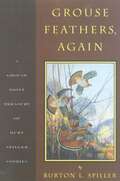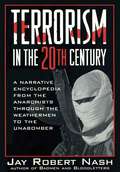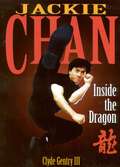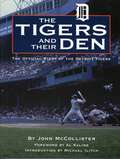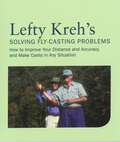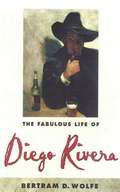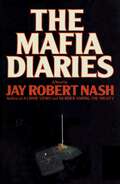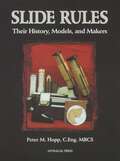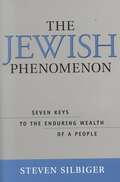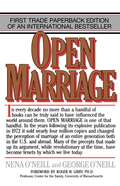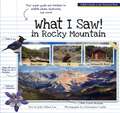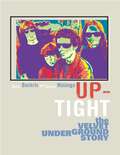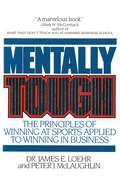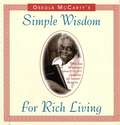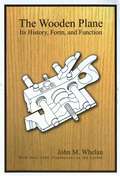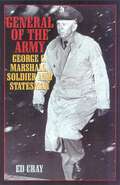- Table View
- List View
Grouse Feathers, Again: The Grouse Point Almanac Presents The Spiller Treasury
by Burton SpillerBurton Spiller's Grouse Feathers is without question the best known book of all time on grouse hunting. His stories have been read and loved since their original publication by The Derrydale Press in 1935. Now, The Derrydale Press is proud to present a new collection of Spiller's stories that have not been previously published in any book.
Terrorism in the 20th Century: A Narrative Encyclopedia From the Anarchists, through the Weathermen, to the Unabomber
by Jay Robert NashThroughout the twentieth century, countless criminal groups have earned infamy by their violent acts of terrorism. Political assassinations, kidnappings, bombings, lynchings and hijackings have stunned the world. In recent decades, terrorism has become an increasing threat, especially when it comes to air travel. Although in this country terrorism is not a new phenomenon, it is one that is growing-and the fear of terrorism is growing faster.
Jackie Chan: Inside the Dragon
by Clyde GentryJackie Chan: Inside the Dragon is the first biography of this international star. Drawn from one-on-one interviews with Chan himself and the actors, actresses, directors, and other stuntmen who've worked with him, fans will finish this book knowing all the details behind Chan's life and films.
Three Little Javelinas
by Susan LowellEveryone knows the story of the three little pigs, but now you're going to meet the three little javelinas (pronounced ha-ve-LEE-nas)-loveable, wild, southwestern cousins of pigs. Living in homes built out of tumbleweeds and saguaro ribs (from the fallen giant cacti), the first two javelinas are soon running from the hungry coyote, who had hoped to eat them with red chile sauce. And where do they go for shelter? Why, to their wise sister's house, made strong with adobe bricks. This clever and humorous tale is sure to delight children of all ages, especially those familiar with the Southwest. Dressed in cowboy duds and prepared for life in the rugged desert, these characters are more than any coyote bargained for.
Mountain Meadow 123
by Caroline StutsonWestern mountain animals and their habitats help teach youngsters how to count to ten and back.Ages 2-6
Tigers and Their Den: The Offical Story of the Detroit Tigers
by John McCollisterShare the fascinating stories about those who have brought to Detroit the unvarnished excitement unique to Tiger baseball.
Lefty Kreh's Solving Fly-Casting Problems: How To Improve Your Distance And Accuracy, And Make Casts In Any Situation
by Lefty KrehLEFTY KREH&’S SOLVING FLY-CASTING PROBLEMS contains detailed descriptions, instructional illustrations, and troubleshooting techniques that every fly fisher needs to know. Lefty offers unparalleled advice about how to cast in windy conditions, how to accurately change the direction of a cast, tame tailing loops, send flies deep, make casts to reach under low branches, and much more. Anyone who has ever missed a fish because of a casting problem (and who hasn&’t?) needs this book.
Links, Lore, & Legends: The Story of Texas Golf
by Art StricklinByron Nelson, Ben Hogan, Lee Trevino, Dave Marr, Ben Crenshaw, Lanny Wadkins, Sandra Haynie, Rick Beem—names known to golfers everywhere—populate Texas golf history. This book chronicles the development of golf in Texas decade by decade focusing on highlighted events, players, pros, teachers, courses, and tournaments. It includes "10 Historic Events You Don't Know About."
Indian & Chinese Cooking from the Himalayan Rim
by Copeland MarksOn his latest adventure, the &‘Indian Jones of the culinary world&’ journeys through the kitchens of East Asia, including the cuisines of Calcutta, Kashmir, and Sikkim. As always, Copeland Marks documents more than just the recipes of these areas, but also fascinating historical facts and personal tales about their origins. A unique food-and-travel-guide, Indian & Chinese Cooking from the Himalayan Rim features over 200 authentic recipes for the adventurous cook.When exploring a land&’s cuisine, Copeland Marks&’ trademark method is to immerse himself in the culture, spending months cooking with its best chefs, professional cooks, and home cooks. The result: another authentic and appetizing addition to his highly praised series of cookbooks.
Robert Crayhon's Nutrition Made Simple: A Comprehensive Guide to the Latest Findings in Optimal Nutrition
by Robert CrayhonAre you looking for one book to explain all of the basics of nutrition and the latest findings? Let Robert Crayhon guide you with his fun, direct, and scientifically documented approach.
The Fabulous Life of Diego Rivera
by Betram D. WolfeKnown for his grand public murals, Diego Rivera (1886-1957) is one of Mexico's most revered artists. His paintings are marked by a unique fusion of European sophistication, revolutionary political turmoil, and the heritage and personality of his native country.Based on extensive interviews with the artist, his four wives (including Frida Kahlo), and his friends, colleagues, and opponents, The Fabulous Life of Diego Rivera captures Rivera's complex personality—-sometimes delightful, frequently infuriating and always fascinating—-as well as his development into one of the twentieth century's greatest artist.
The Mafia Diaries
by Jay Robert NashBrilliant crime historian and reluctant sleuth Jack Journey finds himself once again entangled with the criminal element as he takes on a search for the diaries of a long-dead Sicilian bandit that might hold the key to unraveling a huge network of organized crime.First, a rare-book dealer from whom Journey has arranged to buy an old and valuable collection is found in his loft gruesomely stabbed with a billing spike. Missing is a priceless encyclopedia. Next, a man the killers ,istake for Journey is horribly burned to death in an outdoor market. And then the detective meets darkly exotic Laura Manville—beautiful and seductive—who enters Journey's life like a harbinger of disaster. After leaving his native Chicago to hunt for the killers in New York, he moves on to the treacherous underworld of PAris when clues lead to Europe. There, with growing horror, Journey begins to uncover a chilling link between the recent killings and a mysterious murder almost forty years before.
Slide Rules: Their History, Models, and Makers
by Peter M. HoppIn the hopes of "preserving these delightful devices for future generations," this collector of slide rules covers everything one could possibly want to know about this crude form of analog computer: from its invention in the 17th century to manufacturers- retailers, 1850-1998, and the Oughtred Society for collectors. Includes a glossary with biographies, patent data, component specs, dating and valuing, care, historical milestones, and illustrations
The Jewish Phenomenon: Seven Keys to the Enduring Wealth of a People
by Steve SilbigerWith truly startling statistics and a wealth of anecdotes, Silbiger reveals the cultural principles that form the bedrock of Jewish success in America.
Open Marriage: A New Life Style for Couples
by George O'Neill Nena O'NeillThe classic that revolutionized the way Americans see marriage. Sold more than 35 million copies and translated into 14 languages.
What I Saw in Rocky Mountain: A Kids Guide to the National Park (What I Saw)
by Julie Gillum LueExplore Rocky Mountain National Park—its geology, wildlife, history and more—and keep track of the things you see in the park. See how much you can check off—and have fun looking and learning. Then take this book home to share your Grand Canyon experience with family, friends, and classmates. This guidebook is packed with color photos to help you identify animals, plants, and other features, lively descriptions, fun "guess what" factoids, and precise "where to see it" directions to find the subjects in the book.
Up-Tight: The Velvet Underground Story
by Victor BockrisThe Velvet Underground is arguably one of the most influential American rock bands ever. Based on interviews with former members Lou Reed, John Cale, and Sterling Morrison, as well as others from Andy Warhol's circle of artistic collaborators, Up-Tight is the definitive oral and visual history of the band and its revolutionary, often avant-garde music. Bockris and Malanga's intelligent and entertaining approach-which does not shy away from the drugs, sleaze, and controversy that enveloped the band seemingly from its inception-provides compulsive reading.
The Total Sports Experience for Kids: A Parent's Guide for Success in Youth Sports
by Michael L. Sachs Aubrey H. FineThis book explores the true meaning of achievement in sports: having fun, developing athletic and social skills, and nurturing a healthy, positive sense of self-esteem. Drs. Fine and Sachs offer practical, research-based advice that is bound to enrich the sports experience—as well as life outside of sports—for both children and adults.
Mentally Tough: The Principles of Winning at Sports Applied to Winning in Business
by James E. Loehr Peter McLaughlinSport Psychologist Dr. Jim Loehr and marketing consultant Peter Mclaughlin outline techniques that can be used to achieve the mental toughness displayed by professional athletes. They take these techniques--including visualization, motivation, performance ritual, breath control, and more--and demonstrate how they can be effectively applied in the business world.Mental toughness allows anyone to overcome stress, anger, fatigue, petty problems and workload so they can accomplish their goals, unlock their boundless physical and mental energy and be focused, relaxed and confident in the workplace. The techniques outlined in this book allow anyone to hone their mental toughness and succeed in today's tough business world.
Yellowstone: A National Park Primer
by Sarah Cauble Christopher CaubleWith eleven brilliant color photos of wildlife, geysers, and scenery, this board book is a great way to show the marvels of Yellowstone National Park to very young children. Each photo is paired with a delightful rhyming verse that educationally describes a feature of the photo's subject, from "stinky" thermal springs to "knobby-kneed" moose. Each image was taken in Yellowstone by noted photographer Christopher Cauble; the rhymes were written by Christopher and his wife, Sarah; and the book was designed by Sarah. They created the book to share the wonders of Yellowstone with their young daughter. Yellowstone: A National Park Primer is a wonderful introduction to Yellowstone and to nature for pre-school, beginning readers.Sample rhymes:If you patiently waitand the time is just right,Old Faithful eruptsto a towering height.Find moose in marshy meadowsor beneath the shade of trees.They wade through the waterwith long legs and knobby knees.
Simple Wisdom for Rich Living
by Oseola McCartyInspirational insights from the author, a life-long Mississippi laundress, who in July 1995 at the age of eighty-seven gave $150,000 to the University of Southern Mississippi to establish a scholarship fund and became a national heroine.
Hey Ranger 2: More True Tales of Humor & Misadventure from the Great Outdoors
by Jim BurnettIn this sequel to the wildly successful Hey Ranger: True Tales of Humor and Misadventure from America's National Parks, former ranger Jim Burnett casts his net globally in search of the most outrageous and humorous stories of man in his eternal quest to experience the natural world. Burnett tells of campers being belted by mysterious objects falling from the sky, like potatoes and ice cream; wildlife photos that went awry, including a ground squirrel that outwits a photographer; dumb crooks in parks, such as the drunk driver who mistakenly knocked on a judge's door to report an accident; and drivers who went over the hill and into the woods instead of to Grandma's house.Burnett also assembles contenders for the strangest questions ever asked of a park ranger, lessons on how not to pick a campsite, life lessons you can learn from a canoe trip, as well as some classic bear stories. As always, Burnett's stories are meant to inform as well as entertain, and serve as cautionary tales on how not to become "a victim of your vacation." Told in Burnett's classic, conversational style, Hey Ranger 2 will not disappoint.
Wooden Plane: Its History, Form & Function
by John M. WhelenA comprehensive reference that has been called "a work of clarity and imagination so influential it virtually defines its subject," this book describes, illustrates, and classifies all types of wooden planes from the common to the rare and unusual -- tracing their development and explaining their use. Included are both American and English planes, and also French, Dutch, German, Japanese and Chinese. Over 500 pages long, with more than 1,000 illustrations, it also includes: Chapters that describe and illustrate over 90 simple and 300 complex molding profiles; a description and explanation of the planes used by specific trades: the Cooper, Sashmaker, Coachmaker, Wheelwright, Planemaker, Organ Builder, Staircase Builder, Basketmaker, Rulemaker, Chairmaker, and Patternmaker; an Appendix that outlines a system for naming and classifying molding profiles, and another for identifying and classifying any plane based on its physical shape.
General of the Army: George C. Marshall, Soldier and Statesman
by Ed CrayAs the U.S. Army's Chief of staff through World War II, George Catlett marshall (1880-1959) organized the military mobilization of unprecedented number of Americans and shaped the Allied strategy that defeated first Nazi Germany, then Imperial Japan. As President Truman's Secretary of State, and later as his Secretary of Defence during the Korean War, Marshall the statesman created the European Recovery Act (known as the Marshall Plan) and made possible the Berlin Airlift. Ed Cray in this masterful biography brings us face-to-face with a genuine American hero and the winner of the Nobel Peace Prize.
Adirondack Lullaby
by Brian J. HeinzIn the Adirondack Mountains; as day melts into night; an orchestra plays lullabies; a wilderness delight. Musicians and their instruments; an odd,High Peaks percussion band; gather near and far and wide; to play this rugged land. This North Country concert; from mountain to sky; is music by nature; an Adirondack Lullaby. -- This beautifully-illustrated board book will introduce young readers to the delights of the natural sounds of the Adirondacks.,
